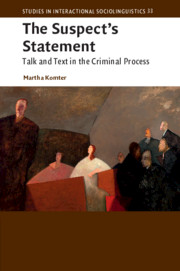
-
Select format
-
- Publisher:
- Cambridge University Press
- Publication date:
- April 2019
- April 2019
- ISBN:
- 9781107445062
- 9781107059481
- 9781107698772
- Dimensions:
- (228 x 152 mm)
- Weight & Pages:
- 0.43kg, 218 Pages
- Dimensions:
- (229 x 152 mm)
- Weight & Pages:
- 0.302kg, 220 Pages
- Series:
- Studies in Interactional Sociolinguistics (33)
You may already have access via personal or institutional login- Series:
- Studies in Interactional Sociolinguistics (33)
Book description
What suspects tell the police may become a crucial piece of evidence when the case comes to court. But what happens to 'the suspect's statement' when it is written down by the police? Based on a unique set of data from over fifteen years' worth of research, Martha Komter examines the trajectory of the suspect's statement from the police interrogation through to the trial. She shows how the suspect's statement is elicited and written down in the police report, how this police report both represents and differs from the original talk in the interrogation, and how it is quoted and referred to in court. The analyses cover interactions in multiple settings, with documents that link one interaction to the next, providing insights into the interactional and documentary foundations of the criminal process and, more generally, into the construction, character and uses of documents in institutional settings.
Reviews
‘Komter identifies a very compelling and troubling social phenomenon; in its most colloquial sense … Her analysis in chapters two and especially three is meticulous and informative, contrasting the distinction between what is said and what is written as a matter of lived work.’
Patrick G. Watson Source: Journal of Pragmatics
‘Komter has produced an ultra-detailed and sophisticated analysis of context in motion, a rare masterpiece reminiscent of ethnomethodological classics from the golden era of institutional ethnography … Her study is must reading for not only those in the ethnomethodological 'community' but also forensic linguists interested in police interviews as well as linguistic anthropologists studying interdiscursivity, extextualization, and multimodality in institutional contexts.’
Gregory Matoesian Source: Discourse Studies
‘The Suspect’s Statement provides a strong foundation for future studies that can examine the suspect’s statement in other contexts, such as judicial opinions and media reports.’
Dakota Wing Source: LINGUIST List
‘In this rigorous book, Komter offers a detailed investigation of entextualisation. Any researcher working on how discourse changes as it is decentered and recentered across contexts will profit from including The suspect’s statement in her or his theoretical framework… ’
Amanda Diniz Vallada Source: Language in Society
Contents
Metrics
Altmetric attention score
Full text views
Full text views help Loading metrics...
Loading metrics...
* Views captured on Cambridge Core between #date#. This data will be updated every 24 hours.
Usage data cannot currently be displayed.
Accessibility standard: Unknown
Why this information is here
This section outlines the accessibility features of this content - including support for screen readers, full keyboard navigation and high-contrast display options. This may not be relevant for you.
Accessibility Information
Accessibility compliance for the PDF of this book is currently unknown and may be updated in the future.


